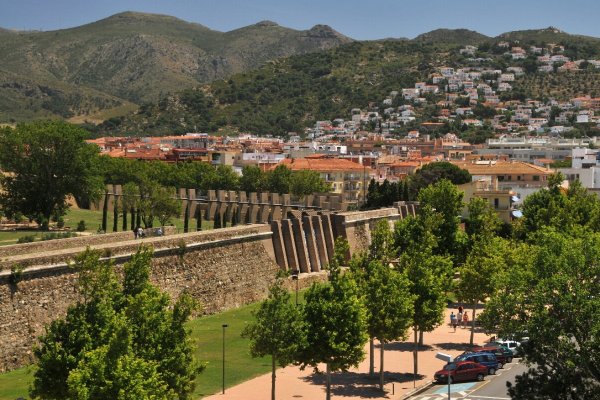CULTURE
The Alt Empordà has unique events showcasting the diversity of cultural offerings in the region, amongst which the museums, music festivals and popular festivals are al well worth seeing, allowing the visitor to see a wealth of attractions and enjoy truly magical moments.
Inhabited since remote times, Roses possesses one of the most complete and impressive megalithic itineraries of the Costa Brava.
Three large dolmens conserve the memory of the area's first settlers: the Creu d'en Cobertella (3000-2700 BC, the Llit de la Generala (3200 BC) and the Cap de l'Home. The Creu d'en Cobertella, the largest dolmen in Catalonia, dates from the Neolithic and was declared a historic-artistic monument in 1964. It has a large gallery covered by a four-ton slab which measures 5.20 m long, 2.45 m wide and 2.14 m high.
The tour around the origins of the town also reveals the funeral chamber of the Casa Cremada and its two menhirs (4th-3rd millennia BC), and the cave-dolmen of the Rec de la Cuana, from 2500 BC.
A walk around the Citadel is essential for anyone visiting Roses.
Declared a historical-artistic comlex in 1961, the Citadel contains vestiges of various periods and occupations. The military fortification, with its monumental Sea Gate, is a Renaissance-style enclosure of 39.000 m2 built in 1543.
Its interior constitues an important archaelogical site, containig the remains of the Greek town of Rhode, founded in 776 BC by traders from the island of Rhodes; the Hellenistic district, which enjoyed its period of greatest prosperity in the 4th and 3rd C. BC; the Roman vil.la, dated between the 2nd C. BC and 6th C. AD; the Lombard Romanesque monastery of Santa MAria, from the 11th C.; and discoveries from the 19th C.
Monastery situated over the bay that was dominated by the typical Mediterranean village of Port de la Selva.
The spectacular appearance of this monastery, together with its conservation turns it into the leading exponent of Romanesque art of the regions of Girona. It also has a fabulous view over the Mediterranean.
It offers the opportunity to know the history of the town. From the neolithic times throught the Greek settlement, the Roman epoch, the Visigothic period, the Middle Ages and the modern period.
Hosts one of the region's most importants art collections, providing the public with a historic interpretation of its collections, which range from a display of archaeological artefacts to collections of Baroque art, and paintings and sculptures from c.XIX-XX as well as some contemporany art.
Hosts an unusual and interesting selection of 4.000 toys. Opened in 1982, is considered one of the best in Europe in its field.
Was conceived by Salvador Dali and it's the world's first and only surrealistic museum.
As well as a series of paintings from the artist's different periods, there is a series of works created by Dali exclusively for the museum.
Is comprised of the Greek city of Emporium and the Roman city of Emporiae, which were the gateway for classical culture on the Iberian Peninsula. This archaeological it covers 2.500 years of history.
Its festivals also define the civilization of a people: they pertain to the culture of leisure, entertainment, and participation. They are often a part of tradition and history. The passage of time has changed many habits and extinguished many customs, but festivals are kept alive and modified to adapt to new circumstances.
Roses has for centuries been taking aboard human values, ancestral customs and popular traditions that have gone to swell its cultural legacy. Over the course of the year, entretainment and gastronomy form an alliance that brings the town's residents and visitors alongside each other.
Gatherings, habanera concerts, concerts of classical, jazz and blues music, firework displays and the famous Carnival of Roses complement the popular dishes such as fish soup-stews and rice dishes that always appear at the festive acts that maintain the warmth of a welcoming town.
Interesting Facts:
JANUARY
5th. Arrival and Great parade of the THREE KINGS OF ORIENT.
FEBRERY OR MARCH
CARNIVAL. This is the oldest carnival in the province and one of the town's most attractive feastdays.
MARCH OR APRIL
HOLY WEEK. Religious celebrations.
APRIL
23th. ST. GEORGE'S DAY. Festival of the book and the rose. Popular performances
MAY OR JUNE
CORPUS CHRISTI. Flower carpets in the main streets of the town.
JUNE
23th. Eve of SAINT JOHN. Arrival of the Canigó torch, firework-running, great bonfire and traditional firework display.
29th. SAINT PETER. Patron saint of fishermen. Popular dancing and “castellers” (human castles)
JULY
Weekly HABANERAS AND SARDANAS.
JAZZ, BLUES AND GOSPEL FESTIVAL.
"CLÀSSICS A LA FRESCA" Open-air classical music concert cycle at the church of the Roses Citadel.
AUGUST
Weekly HABANERAS AND SARDANAS.
JAZZ, BLUES AND GOSPEL FESTIVAL.
"CLÀSSICS A LA FRESCA" Open-air classical music concert cycle at the church of the Roses Citadel.
15th & 16th: TOWN FESTIVAL. Over the course of this festival, and throughout the entire month there are concerts of classical, modern and rock music, theatre shows, popular dances, folk meetings, various exhibitions, sports competitions, fireworks, traditional sardana dancing, crafts fair, parade of costume giants and end-of-festival dance.
SEPTEMBER
11th. CATALONIA DAY. All day, speeches and public events.
DECEMBER
CHRISTMAS HOLIDAYS. Traditional Christmas plays “Pastorets”, classical music concerts, children's and young people's entertainments exhibitions, choice of Miss Roses (Pubilla).
24th. Midnight Mass
31th. New Year's Eve.

 The Megalithic Park
The Megalithic Park









































